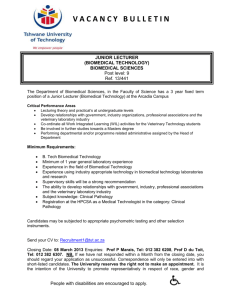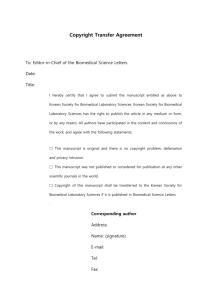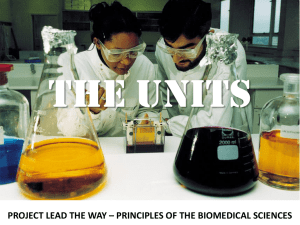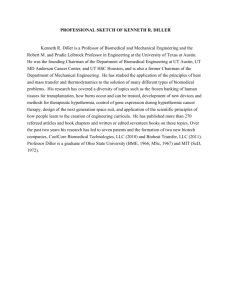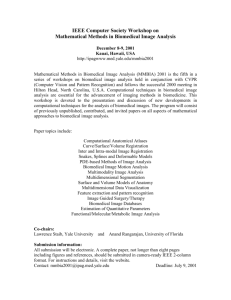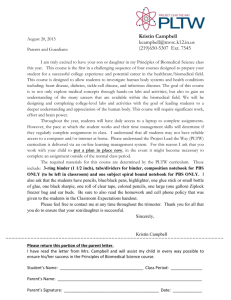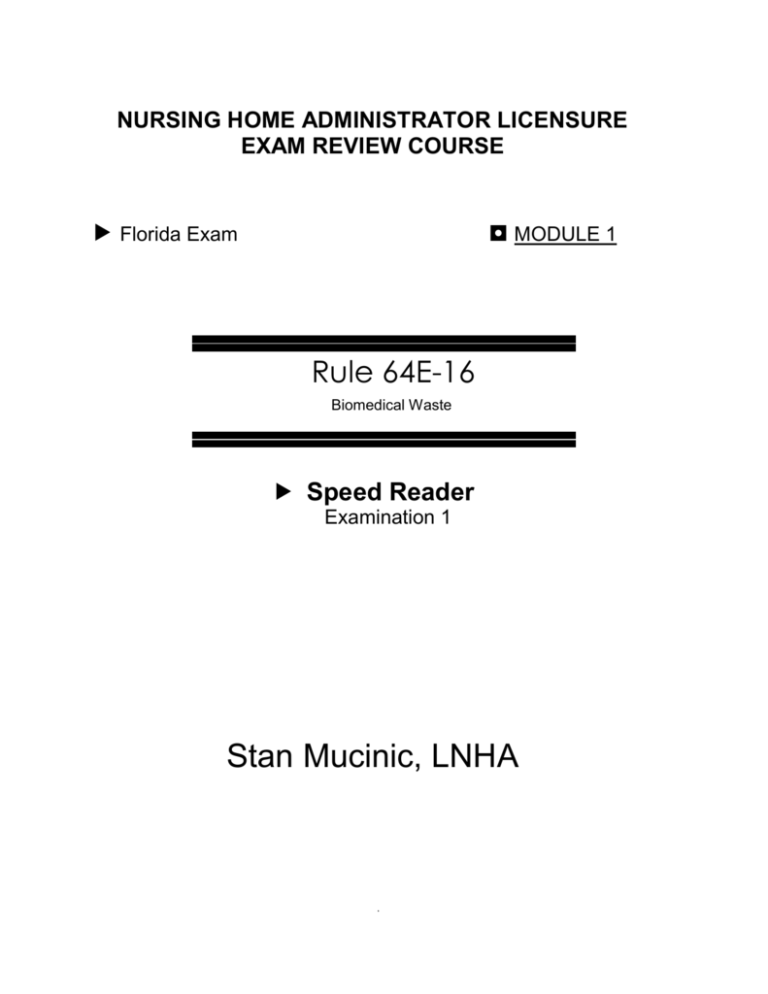
NURSING HOME ADMINISTRATOR LICENSURE
EXAM REVIEW COURSE
◘ MODULE 1
Florida Exam
referencsection
Rule 64E-16
Biomedical Waste
Speed Reader
Examination 1
Stan Mucinic, LNHA
.
64E-16 Module 1
Copyright © Stanley Mucinic 2005-2012. All rights reserved.
0 of 7
LEGAL NOTICES
Students enrolled in the “Florida Nursing Home Administrator Licensing Course” are purchasing
professional knowledge of the instructor to assist the student to prepare for the State Laws and
Rules Exam administered by the National Association of Boards of Examiners (NAB).
This is a 3-week intensive independent study program designed to provide students a unique
personalized and structured learning environment where progress is monitored by the instructor
through email to help students maintain focus and complete scheduled assignments timely.
THE INSTRUCTOR MAKES NO EXPRESS OR IMPLIED WARRANTY OR REPRESENTATION
OF ANY KIND THAT COMPLETION OF THIS OR ANY LICENSURE PREPARATION COURSE
OFFERED BY INSTRUCTOR WILL GUARANTEE A PASSING SCORE ON ANY LICENSING
EXAM.
An individual’s ultimate success in passing the licensure exam is dependent on an individual’s
professional experience, academic preparation, and the time and energy the individual can commit
to exam study and preparation. A student’s work schedule or other commitments may require more
time to prepare for an exam than allotted by NAB or state licensing boards. The student is solely
responsible for licensing exam registration/testing and retesting fees.
HOW TO USE THE STUDY GUIDES
Step 1 – VERY IMPORTANT - The personalized test organizer that comes with the program is the key to your
success and sets this program apart from any other. It is critical you follow the instructions and score each
exam, and file the completed exams into your binder. Try to keep to the schedule and email your test results
to the instructor to stay focused.
Step 2. - Speed Reader – Read the speed reader for each module once or twice before taking the module
exam(s). Read the speed reader over and over again until you familiarize yourself with its contents. THE
MORE TIMES YOU LOOK IT THE MORE LIKELY YOU ARE TO REMEMBER IT.
Step 3 – Exam Packet - The exam packet contains questions designed to measure your comprehension and
retention of the material you read. Take each exam over and over again until you score 100%. Make sure
you score each exam and record the results in your organizer or you will not be able to gauge your progress.
The exam questions are cross referenced to the speed reader to allow you to quickly find and review material
you missed on the exam as follows:
Page Number
2/1.8(13)
Section number
Thus, the specific material would be found on page 2 of the speed reader, section 1.8, subparagraph 13.
Contact Information
Email Stan Mucinic at smucinic@yahoo.com with any questions and after you score each practice
exam.
64E-16 Module 1
Copyright © Stanley Mucinic 2005-2012. All rights reserved.
1 of 7
CHAPTER 64E-16 BIOMEDICAL WASTE
Table of Contents
Section
1
2
3
4
5
6
7
8
9
10
11
12
13
14
15
16
64E-16 Module 1
Topic
Page
General
Definitions
Policies and Procedures
Storage and Containment
Packaging Waste Materials
Sharps Containers
Labeling
Waste Generator
Waste Treatment
Waste Transport
Registered Transporters
Inspections
Permits
Fees
Enforcement and Penalties
Biomedical Waste Plan
Copyright © Stanley Mucinic 2005-2012. All rights reserved.
3
3
4
4
5
5
5
6
6
6
6
6
7
7
7
7
2 of 7
BIOMEDICAL WASTE
SECTION 1 - GENERAL
1.1 - GENERAL
1. This rule establishes minimum standards to manage, handle, label, transport and treat
biomedical waste
2. This rule applies to nursing homes because these facilities generate and store biomedical
waste in the form of waste products that contain blood, bodily fluids, used syringes, and
infectious agents that need to be properly bagged, stored and handled to prevent
transmission of disease in the facility or contamination to the environment
3. Department of Health - regulates the packaging, transport, storage, and treatment of
biomedical waste
4. Department of Environmental Protection - regulates biomedical waste incineration and
biomedical waste disposal
5. Home Users - Health care providers must inform home user clients verbally and in writing of
the recommended method for handling biomedical waste generated in the home setting
6. In Home Medical Users - Providers who deliver in-home medical services must arrange to
have biomedical waster produced in client home removed by biomedical waste transporter
7. The transporter will give you a receipt with the date of pickup and the weight of the pickup,
You will need to produce these receipts to the health dept when they visit to prove proper
disposal of biomedical waste
SECTION 2 - DEFINITIONS
2.1 - DEFINITIONS
1. American Society for Testing Materials, also referred to as ASTM – A technical society that
publishes national standards for the testing and quality assurance of materials
2. Biomedical waste – Any solid or liquid waste which may present a threat of infection to humans,
including non-liquid tissue, body parts, blood, blood products, and body fluids from humans and
other primates; laboratory and veterinary wastes which contain human disease-causing agents,
and discarded sharps
Biomedical waste includes:
(a)
(b)
(c)
(d)
Used, absorbent materials saturated with blood, blood products, body fluids
Excretions or secretions contaminated with visible blood
Absorbent materials saturated with blood or blood products that have dried
Non-absorbent, disposable devices that have been contaminated with blood or
bodily fluids visibly contaminated with blood
3. Biomedical waste generator – A facility or person that produces biomedical waste (includes
hospitals, skilled nursing or convalescent hospitals, intermediate care facilities, clinics, dialysis
clinics, dental offices, health maintenance organizations, surgical clinics, medical buildings,
physicians' offices, laboratories, veterinary clinics and funeral homes)
4. Body fluids – Those fluids which have the potential to harbor pathogens, such as human
immunodeficiency virus and hepatitis B virus and includes:
a)
b)
c)
d)
Blood and blood products
Lymph
Semen and vaginal secretions
Cerebrospinal, sinovial, pleural, peritoneal, pericardial and amniotic fluids.
5. “Regulated bodily fluids” are fluids that cannot be identified and must be treated as a regulated
body fluid
6. Feces and secretions such as nasal discharges, saliva, sputum, sweat, tears, urine, and vomit
are not considered biomedical waste unless visibly contaminated with blood
7. Contaminated – Soiled by any biomedical waste
8. Decontamination – Process of removing pathogenic microorganisms from objects or surfaces
64E-16 Module 1
Copyright © Stanley Mucinic 2005-2012. All rights reserved.
3 of 7
2.1 Definitions
(Cont’d)
9. Disinfection – Process that uses dry heat, chemicals, or microwave shredding to kill bacteria
10. Facility – All contiguous land and structures owned, operated, and licensed as a single entity
which may consist of several generating, treatment or storage units.
11. Health Care Provider – Any person who provides medical care to another individual
12. Home User – An individual who generates biomedical waste as a result of self-care or care by a
family member or other non health care provider
13. Outer Biohazard Material container – Any rigid type container used to enclose packages of
biomedical waste (does no include cardboard or paper containers)
14. Packages – Any material that completely envelops biomedical waste (includes red bags, sharps
containers and outer containers)
15. Person – Any individual, partnership, corporation or public body that generates, stores,
transports, or treats biomedical waste
16. Point of origin – The room or area where the biomedical waste is generated.
17. Sharps – Objects capable of puncturing, lacerating, or otherwise penetrating the skin
18. Sharps container – A rigid, leak and puncture resistant container, designed to contain sharps,
and clearly labeled with the phrase and international biological hazard symbol
19. Sterilization – Any process, including steam, chemicals, microwave shredding, or incineration,
which changes the character or composition of biomedical waste to render it noninfectious
20. Storage – The holding of packaged biomedical waste for a period longer than 30 days at a
facility or in a transport vehicle
21. Transport – The movement of biomedical waste away from a facility
22. Transport Vehicle - A motor vehicle, rail car, watercraft or aircraft used to transport biomedical
waste
23. Treatment - Any process, including steam, chemicals, microwave shredding, or incineration,
Which renders biomedical waste noninfectious by disinfection or sterilization
SECTION 3 - POLICIES AND PROCEDURES
3.1 - FACILITY POLICIES AND PROCEDURES
1. Hazardous Waste - Biomedical waste mixed with hazardous waste is managed as hazardous
waste
2. Untreated Biomedical waste - Solid waste or liquid, that is neither hazardous nor radioactive,
combined with untreated biomedical waste must be managed as untreated biomedical waste
3. Staff Training requirements:
a)
b)
c)
d)
Must train new personnel who handle biomedical waste in their job
Training must be provided before worker can handle any biomedical waste
Refresher training must be provided annually
Training must detail compliance with the facility's operating plan
4. Records - All biomedical waste management records must be maintained for 3 years and be
available for review by the Department of Health
SECTION 4 - STORAGE AND CONTAINMENT
4.1 - STORAGE AND CONTAINMENT
1. Cannot store biomedical waste in a facility longer than 30 days.
2. The 30-day period starts when the first non-sharps item of biomedical waste is placed into a
red bag or sharps container, or when a sharps container containing only sharps is sealed
3. Storage of biomedical waste in a place other than the generating facility must not exceed 30
days (30 day storage period begins on day the waste is collected from the generator)
4. Indoor biomedical waste storage areas must have restricted access and be located away
from pedestrian traffic, be vermin and insect free, and maintained in a sanitary condition
64E-16 Module 1
Copyright © Stanley Mucinic 2005-2012. All rights reserved.
4 of 7
4.1 – Storage and Containment (Cont’d)
5. Outdoor storage areas (containers and trailers) must be conspicuously marked with the
international biological hazard symbol and secured against vandalism and unauthorized entry
6. The international biological hazard symbol on an outdoor storage area must be a minimum of
6 inches in diameter
SECTION 5 - PACKAGING OF WASTE MATERIALS
5.1 - CONTAINERS
1.
2.
3.
4.
Packaging containing biomedical waste must remain sealed until treated
Ruptured or leaking packages of biomedical waste must be placed into larger packaging without
disturbing the original seal
All packages containing biomedical waste must be identifiable with the international biological
hazard symbol and one of the following phrases: “BIOMEDICAL WASTE”, “BIOHAZARDOUS
WASTE”, “BIOHAZARD”, “INFECTIOUS WASTE”, or “INFECTIOUS SUBSTANCE”
The symbol must be red, orange, or black with contrasting background color
5.2 - PLASTIC BAGS
1.
2.
Biomedical waste, except sharps, must be packaged and sealed at the point of origin in
impermeable, red plastic bags or sharps containers
The international biological hazard symbol must be at least:
a)
b)
3.
6 inches in diameter - bags 19´´ × 14´´ or larger, and
1 inch in diameter - bags smaller than 19´´ × 14´´
Each plastic bag must meet the following physical properties:
a)
b)
Have an impact resistance of 165 grams and tearing resistance of 480 grams in both the
parallel and perpendicular planes with respect to the length of the bag
Incidental sum concentrations of lead, mercury, hexavalent chromium and cadmium
cannot be more than 100 ppm for dyes used in the coloration of bags
SECTION 6 - SHARPS CONTAINERS
6.1 -SHARPS CONTAINERS
1.
2.
3.
4.
5.
6.
7.
8.
Sharps (needles) must be discarded at point of origin into single use or reusable containers
Needles and scalpel blades must not be placed directly into double-walled corrugated containers
Sharps containers must be sealed when full
A sharps container is considered full when materials reach the designated fill line or additional
materials must be crammed in and there is no room for additional materials
Reusable sharps containers may only be emptied into treatment carts or treatment unit
Sharps containers must be decontaminated after each use
International biological hazard symbol must be 1 inch in diameter on sharps containers
All outer containers must be rigid, leak-resistant and puncture-resistant
SECTION 7 - LABELLING
7.1 - LABELING
1. Biomedical waste bags and containers must be labeled with the generator's name and
address unless treatment occurs at the generating facility
2. If a bag or sharps container is placed into a larger bag prior to transport, the exterior bag
must be labeled
3. Inner bags and inner sharps containers are exempt from labeling requirements
4. Outer containers must be labeled with the transporter's name, address, registration number,
and 24-hour telephone number prior to transport
64E-16 Module 1
Copyright © Stanley Mucinic 2005-2012. All rights reserved.
5 of 7
SECTION 8 – WASTE GENERATOR
8.1 - WASTE GENERATOR REQUIREMENTS
1. A biomedical waste generator must not negotiate transport of biomedical waste with a person
who is not a registered biomedical waste transporter
2. Biomedical waste packages must not be compacted to a density greater than 22 lbs cubic ft.
3. Compacted packages of biomedical waste must not be subjected to further compacting
4. Any residual or incidental liquid must be contained within the inner bag or outer container
5. Discharge of noxious air must be kept to a minimum through use of HEPA filters having a
pore size of 2 microns or less, negative pressure rooms, or other safety methods
6. Compacted packages of biomedical waste must be treated by incineration or other approved
treatment process
SECTION 9 - WASTE TREATMENT
9.1 - WASTE TREATMENT.
1. Biomedical waste must be treated by steam, incineration, or an alternative process approved
by the department prior to disposal
2. Treatment must occur within 30 days of collection from the generator
3. Incineration of biomedical waste must be performed in a biological waste incinerator
permitted by the Department of Environmental Protection
SECTION 10 - WASTE TRANSPORT
10.1 - WASTE TRANSPORT
1. No registered transporter may knowingly accept biomedical waste for transport unless it has
been properly segregated, packaged, and labeled
2. Each registered transporter must provide the generator with a receipt of pick-up
3. Transfer of biomedical waste from one transport vehicle to another is not allowed unless the
transfer occurs at a permitted storage or treatment facility
4. No registered transporter may knowingly deliver biomedical waste for storage or treatment to
a facility which does not have a valid permit issued by the department
5. All transport vehicles containing biomedical waste shall be visibly identified with the business
name, registration number, a 24 hour telephone number, and placards showing the phrase
and the international biological hazard symbol shall be at least 6 inches in diameter
6. All transport vehicles containing waste must be fully enclosed and secured when unattended
7. Registered transporters must notify the department within one working day by telephone
and submit a follow-up report to the department within 10 days, in writing, of an accidental
spill
SECTION 11 - WASTE TRANSPORTERS
11.1 - REGISTRATION OF BIOMEDICAL WASTE TRANSPORTERS
1. Biomedical waste transporters must be registered with the Department of Health
2. Biomedical waste generators transporting less than 25 pounds of their own biomedical waste,
in their own transport vehicle, on any single occasion, are exempt from transporter
registration fees
SECTION 12 - INSPECTIONS
12.1 INSPECTIONS
1. Permitted generators (nursing facilities) are inspected annually on Sept 30th
2. Re-inspections may be conducted when a facility is found to be in non-compliance
64E-16 Module 1
Copyright © Stanley Mucinic 2005-2012. All rights reserved.
6 of 7
SECTION 13 - PERMITS
13.1 - PERMITS
1. The facility permits expires on September 30 each year
2. The facility permit is valid for 12 months and is renewed annually
3. A biomedical waste generator, who produces or treats less than 25 pounds of biomedical
waste in each 30 day period is exempt from all permit and fee requirements
4. Change of ownership of facility or a newly constructed facility – must submit an application for
initial permit within 30 days of the start of business
5. Leased Facility by owner to second party for operation - the second party must apply for an
initial permit within 30 days of the commencement of business
6. The permit must be maintained in the facility and be available for review by the department
7. Persons engaged in a sharps collection program with single or multiple facility locations may
operate under a single permit
SECTION 14 - FEES
14.1 - FEES.
1. When the facility will be in operation six (6) months or less before the annual renewal date,
the annual fee shall be prorated on a quarterly basis
SECTION 15 - ENFORCEMENT AND PENALTIES
15.1 - ENFORCEMENT AND PENALTIES
1. Any person who generates, transfers, treats, stores, transports or disposes of biomedical
waste illegally or hinders or impersonates a department employee is chargeable with a
second degree misdemeanor
SECTION 16 – BIOMEDICAL WASTE PLAN
16.1 – BIOMEDICAL WASTE PLAN
1. Must have a written operating plan to manage biomedical waste that describes:
a)
b)
c)
d)
Staff training
Procedures to segregate, label, package, transport, store and treat biomedical waste
Procedures to decontaminate biomedical waste spills
Contingency plan for emergencies
64E-16 Module 1
Copyright © Stanley Mucinic 2005-2012. All rights reserved.
7 of 7


